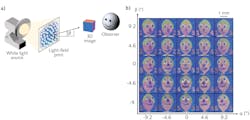Researchers from the Singapore University of Technology and Design (SUTD) have developed a way to go beyond the fixed appearance of 2D imaging.
Using a nanoscale 3D printing technique, the team was able to create high-resolution light field prints (LFPs), comprising an array of microlenses that are aligned atop an array of structural color pixels.1 According to the researchers, a 3D image is displayed when the LFP is illuminated by basic white light. That image is “autostereoscopic”—it can be viewed without needing special glasses. In the study, the image changed appearance as the researchers viewed it from various angles—this gave the LFP a different 3D visual effect (see figure).
“This is possibly the first time that 3D printing is used to entirely create a multicolored light-field print in a single step, without the use of dyes, and without the need for manual alignment of microlenses to the color pixels,” says SUTD Associate Professor Joel Yang, the principal investigator of the research.
High-resolution LFPs are needed to display ultrarealistic 3D images, he added; the team achieved a maximum pixel resolution of 25,400 dpi. Yang says this surpasses the pixel resolution of consumer inkjet printers, which is ~1200 dpi.
The structural color pixels in the LFP are made of nanopillars (~300-nm diameter), the researchers found, which they say is “perhaps the most remarkable result is that each color pixel can be represented by a single nanopillar to produce the LFP at its maximum resolution.”
“The prints are embedded with up to 225 frames within a single LFP to generate smooth viewing transitions at unprecedented resolution,” Yang says. “These effects will lead to 2D prints that produce ultrarealistic 3D visuals in the future.”
Traditionally, prints such as photographs display 2D images with a fixed appearance, containing only intensity and color information. These 2D prints can’t display a 3D image “because they lack directional control of light rays, hence resulting in the loss of depth information.” The SUTD team’s research addresses this problem.
High-resolution LFPs should become more readily available in the market, according to the researchers, when nanotechnology allows greater scalability and throughput. Potential applications include imaging artwork and security items.
REFERENCE
1. J. Y. E. Chan et al., Nat. Commun., 12, 3728 (2021); https://doi.org/10.1038/s41467-021-23964-6.

